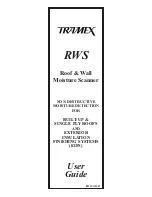
This identifies where the elevated moisture is located.
Mark the roof surface with crayon or paint, outlining
the area of wetness. See Fig 6. below
Fig 6. Tracing And Marking A Leak On Your Roof
To trace the leak back to the source, turn down the sen-
sitivity until the meter needle reads approximately half
scale. Take point readings around the area of the leak,
following the strongest signal. It may be necessary to
reduce the sensitivity a number of times until the area
of greatest moisture content is located. Based on the
usual pattern of greatest moisture concentration being
in proximity to the point at which the moisture gets
through into the roof, a visual examination of the area
should be carried out to identify defects or damage to
the roof covering.
Note: The reading on the
RWS
. is ‘Relative or
Comparative’, indicating a greater or lesser signal. It is
not an indicator of percentage moisture content. As a
guide, approximately 20% moisture in wood fibreboard
directly under 3mm (1/8”) membrane, will give
full-scale deflection on Roof mode on the
YELLOW
sensitivity range. Many types of insulation currently
available can contain up to 200% moisture by weight
while others can hold no more that 50%. If the precise
moisture content is required we recommend a sample
core is cut and measured by weigh/dry/weigh method,
or by use of a pin type resistance moisture meter. The
Tramex Compact
pin meter could be used to give an
indication of quantative moisture content.
Types Of Roofing Structures And Their More
Common Problems
•
Built-up Roofing Systems
: Comprising of 3 or 4
layers of roofing felt, with bitumen or asphalt adhe-
sive between each layer.
•
Modified Bitumen Systems
: This type of material
is usually heat applied as a single layer system or
with a base layer of bituminous felt.
R.W.S.
User Guide
Summary of Contents for RWS
Page 18: ... R W S User Guide ...



















